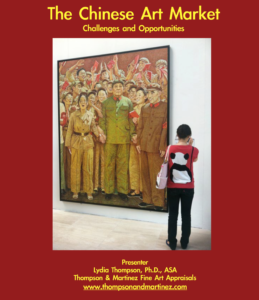Chinese monumental handscroll, ink and color on silk, 18th/19th century SOLD
Length: overall 158 inches, scroll 146 3/4 inches
Height: overall 19 5/8 inches, scroll 12 1/4 inches

detail, panel 7

detail, river scene
Chinese monumental ink and color on silk hand scroll, 18th-19th century, Village Life, available through iGavel Auctions
Length: overall 158 inches, scroll 146 3/4 inches
Height: overall 19 5/8 inches, scroll 12 1/4 inches

detail, panel 7

detail, river scene
Chinese Hand Scroll Bid Here Now
Now Through April 16
The Tax Cuts and Jobs Act of 2017, Some Things for Art Collectors to Consider
In late 2017, President Trump signed into law, the Tax Cuts and Jobs Act, which went into effect on January 1, 2018. Tax attorneys and accountants are in the process of unpacking this law, and how it affects their clients’ personal and business interests. Personal Property appraisers, those of us who value a wide range of tangible assets, including fine art, rare books, collectibles, jewelry, automobiles and yachts among many other things, also need to understand how this will affect our clients, from the perspective of estate planning, donation, gifting, inheritance and sale. As is commonly known, the 2017 tax reform bill doubles the exemptions for estate tax up to $11.2 million for individuals and $22.4 million for a couple. For the vast majority of U.S. citizens, this will eliminate the need for an appraisal for estate tax calculation.
For those whose estates have an overall value above this new federal exemption threshold, beneficiaries will still need a Fair Market Value appraisal, as of the date of death, of their personal property. For example, a painting by an artist like Jean-Michel Basquiat (1960-1988), purchased by the deceased in 1985 for $10,000 will, given the exponential growth in Basquiat’s market, be worth significantly more in 2018. This stepped-up basis is not only required for estate tax calculation but also for any possible future sale and reporting for income tax. If the painting is sold for $200,000 in 2019, the 28% capital gains tax will be based on the 2018 appraised value rather than the 1985 purchase price. The tax basis of any gifts of personal property transferred within a family, say from mother to daughter while the mother is still alive, is subject to the donor’s tax basis not the donee’s. It may be worth delaying such a gift in order to obtain the after death stepped-up in basis tax benefit.
When it comes to your art collection, these are just a few things to consider in light of the tax reform bill. And remember, the federal estate tax exemption levels are set to expire at the end of 2025, reverting back to the 2017 levels.
What’s So Bad about Auction Houses Preparing Appraisals for the IRS? A Recent Case
In the recent case (February 22, 2017) of the Estate of Kollsman v. Commissioner, the U.S. Tax Court ruled that the estate had significantly underreported the value of artworks to the IRS for estate tax purposes. The court found that the values were unpersuasive because the auction house specialist who had prepared the appraisal was found to have exaggerated the poor condition and risk of cleaning the Old Master paintings under consideration. More importantly, the auction specialist who produced the appraisal report was, at the same time, soliciting the works for consignment, which could result in significant commissions from the sale. Not surprisingly, the court found that the auction specialist had a significant conflict of interest in preparing the appraisal report stating: “he had a direct financial incentive to curry favor with [the executor]” by providing “‘lowball’ estimates that would lessen the Federal estate tax burden borne by the estate.”
Collectors, estate administrators and fiduciaries should be aware that to reduce the risk that an appraisal prepared for Estate Tax calculation or Charitable Contribution will later be deemed unreliable, independent appraisers who have no financial interest in the property should be retained. When hiring an appraiser look for an appraiser who prepares appraisal reports in compliance with the Uniform Standards of Professional Appraisal Practice USPAP, the generally recognized performance standards for the appraisal profession in the U.S.. All reports conforming to USPAP include a certification that the opinions expressed in those reports are the appraiser’s unbiased professional opinions, and that the appraiser has no present or prospective interest in the property being appraised or personal interest with respect to the parties involved (or if such interests exist, they must be disclosed).


